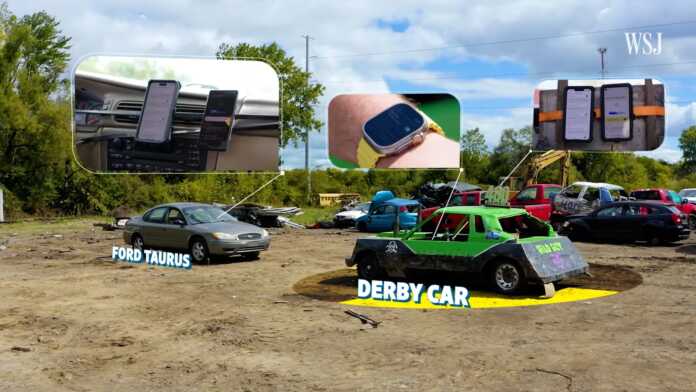The new accident detection feature of the latest Apple devices — iPhone 14 and Apple Watch Ultra / 8 / SE (2nd gen) — processes sensor data to detect a collision.
If you don’t respond to on-screen prompts, an alarm sounds and then automatically calls emergency services and provides your location. Google also offers similar functionality on its devices. Pixel for a long time.
But it works? To find out, WSJ has crashed a few cars with the help of Michael Barabe, a demolition champion from Monroe, Michigan.
WSJ placed an iPhone 14 Pro Max and Pixel 6 Pro in the two junkyard cars they were going to hit — a 2003 Ford Taurus and a 2008 Dodge Caravan. In the car that was driven by the specialist, they placed an iPhone 14 and a Pixel 5, and the driver wore an Apple Watch Ultra on his wrist.
About five seconds after first crash against the Ford Taurus head-on, at about 25 mph, the Apple Watch Ultra on my wrist beeped an alert: “Looks like you had an accident.” Phones went flying to the floor of his car. Apple designed the feature to display the alert on the Watch if it’s paired with an iPhone.
Even though the Taurus’s driver-side airbag went off — and the entire front of the car was shattered — the iPhone and Pixel in the car that was hit didn’t detect a crash. Neither did the Pixel in the car that crashed.
In the second crash, the Taurus’s passenger-side airbag deployed and the bumper flew off. Again, the Taurus phones showed no alerts. Inside the car being driven, the Pixel detected the crash, but this time the Apple devices didn’t.
In the third test, the car being driven crashed into the Dodge Caravan at around 40 km/h, shattering the windshield and activating the airbags. Again, the iPhone and Apple Watch in Michael’s car showed an alert, but the Pixel didn’t. The Pixel and iPhone in the Dodge showed nothing.
When the WSJ contacted Apple with the results, a company spokesperson said that Junkyard test conditions didn’t provide enough signals to the iPhone to trigger the feature on stationary cars.
It was not connected to Bluetooth or CarPlay, which would have indicated the car was in use, and the vehicles may not have traveled enough distance before the crash to indicate they were driving. If the iPhone had received those additional indicators — and if its GPS had shown that the cars were on a real road — the likelihood of an alert would have been higher, she said.
A Google spokesperson also said that not only is the severity of a crash a factor, but likewise, the algorithm first has to detect that you’re driving.














